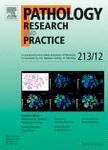版权所有:内蒙古大学图书馆 技术提供:维普资讯• 智图
内蒙古自治区呼和浩特市赛罕区大学西街235号 邮编: 010021

作者机构:Third Mil Med Univ Southwest Hosp Dept Orthoped Surg Chongqing 400038 Peoples R China Third Mil Med Univ Chongqing Key Lab Neurobiol Dept Neurobiol Chongqing 400038 Peoples R China Bengbu Med Coll Dept Orthoped Surg Affiliated Hosp Bengbu 233030 Anhui Peoples R China
出 版 物:《PATHOLOGY RESEARCH AND PRACTICE》 (病理学研究与实践)
年 卷 期:2013年第209卷第12期
页 面:790-796页
核心收录:
学科分类:1001[医学-基础医学(可授医学、理学学位)] 10[医学]
基 金:National Science Foundation of China [30973065 81171035]
主 题:Bone cancer Steroid Steroid receptor coactivators SRC-3 Immunohistochemistry Tissue microarray
摘 要:Bone tissue is steroid-responsive and profoundly regulated by steroids and/or their receptors. Bone cancers (either primary or metastatic) belong to the most dangerous tumors. Previous studies have demonstrated overexpression of steroid receptor coactivator-3 (SRC-3) in many cancers, such as breast cancer, prostate cancer, thyroid cancer, functioning in the regulation of cancer cell proliferation, invasion, and metastasis. However, so far, the expression and function of SRC-3 in bone cancers have not yet been clarified. In this study, nickel-intensified immunohistochemistry was conducted using a commercial tissue microarray (with 94 cases of bone cancer tissue and 10 normal bone tissues), and the 4-scoring system was employed to evaluate the expression levels of SRC-3 immunoreactivity. The results showed that in normal bone tissue, levels of SRC-3 are almost negative (score = 0), the total positivity (score = 1-3) of SRC-3 immunoreactivities in bone cancers was 74.47%. There were no significant differences in gender, status (malignant or benign) or (mean) age (p 0.05). The percentage of positivity was 77.78% in osteogenic tumors, 58.82% in cartilage tumors, 70% in giant cell tumors, 100% in hematopoietic tumors, 77.78% in miscellaneous lesions, and 75% in miscellaneous tumors. Age related differences of SRC-3 immunoreactivities were detected in cartilage tumors and giant cell tumors (p 0.05). The above results clearly demonstrated a high frequency of overexpression of SRC-3 immunoreactivities in different bone cancers, indicating its potential roles in the prognosis and treatment of these cancers. (C) 2013 Elsevier GmbH. All rights reserved.